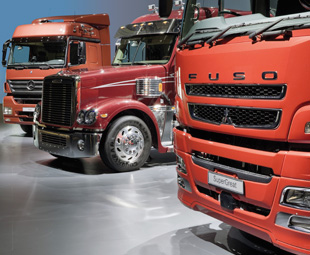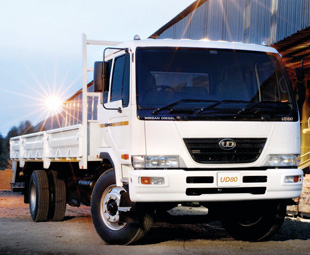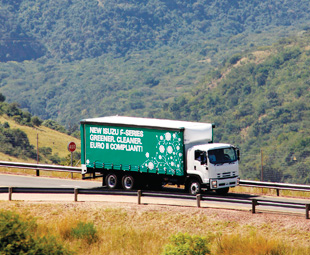Product shortage looms!

Things are looking good, writes FRANK BEETON, after analysing truck sales during the second quarter of 2011. But what about stock availability in the months ahead? Could operators be faced with a crisis?
The South African truck market has ended the first six months of 2011 on a strong note, despite widespread concerns that product availability, in the wake of the Tōhoku earthquake and tsunami that struck Japan early in March, would act as a constraint on sales volumes. It was notable that the total market, during the first half of the current year, outperformed the equivalent first half-year result for 2010, by 23,3%, and that the returns of manufacturers sourcing their vehicles from Japan did not show substantial recent deterioration, in terms of absolute volume. This suggests the supply situation has been managed more satisfactorily than had originally been feared. However, this does not suggest that individual models or variants have not been affected, or that all products will be freely available in the months immediately ahead.
It has become evident that some operators have been understandably protecting their interests by buying up the available stock from dealers, manufacturers and importers. This is particularly important where specific models and variants were required, and although suppliers had been commendably candid with warnings of possible shortages, the exact supply environment remained largely unpredictable.
This situation worked in favour of those purchasers with cash resources and strong balance sheets, who were able to move quickly into the acquisition process. Smaller operators may well have found themselves less able to take advantage of short-term product availability, and the movement of the sales mix upwards, in favour of the EHCV segment, has borne this out.
In the comparison between the second quarter of 2011 and the first quarter, total sales volume grew by just 0,6%, once again reinforcing the consistent nature of the market during the first half of this year. This pattern emerged despite the interventions of disruptive influences including a volatile truck drivers’ strike during February, accompanied by violence and intimidation, which mitigated the movement of commercial vehicles in what was already a month containing less than the average number of working days.
The early months of 2011 were also characterised by an extremely volatile oil price, caused by political unrest in the Middle East, that impacted on the local cost of fuel, and consequently on the short-term profitability of haulage contractors.
The recent pattern of vehicle deliveries has shown a clear bias towards heavier, more expensive units, confirming that demand levels in the economy are healthy, and that the availability of acquisition finance remains satisfactory. The broader macro-economic picture in the South African economy has suggested some softening of local business confidence, as evidenced by the most recent Kagiso Purchasing Managers’ Index, but the most important challenge facing the suppliers of trucks, buses and vans going forward will be in obtaining the optimum balance between the vehicles that they can supply, and the requirements of their customers.
SEGMENTATION DYNAMICS
During the second quarter of 2011, the premium payload EHCV segment has consolidated, and strengthened the dominant position it has occupied in the overall market over the four most recent quarters, reaching a penetration level of 45,7%, which is the highest ever on record for this category. In stark contrast, the entry level MCV grouping retreated to 30,7% market share, which is the lowest achieved by this segment since the mid-1980s.
These contrasting fortunes of the EHCV and MCV segments are worthy of comment, bearing in mind that the heavier vehicles are sold mainly to professional hauliers, often in significantly large batches, whereas many entry-level trucks, vans and buses are purchased by small businesses, often one at a time. The recent sales pattern may be an indication that acquisition finance has become more freely available to well-managed big fleets, whereas smaller businesses have come under increased scrutiny before credit can be secured.
The cruiserweight HCV category continues to occupy a position very close to the 20% penetration level that it has maintained over much of the past decade, while the bus segment appears to be entering a new period of more stable normality, following the stimulation provided during 2009 and 2010 by the Soccer World Cup tournament, and has achieved a penetration level of 4,6% during the quarter just ended.
It was notable that bus sales enjoyed their best individual month performance for the year to date in June, and have exhibited an increasing trend, in terms of absolute monthly deliveries, since the beginning of the year.
MANUFACTURER PERFORMANCE
Chart 1 illustrates the relative market performance and ranking of each participating manufacturer in the quarter just completed, as compared to the returns for the first quarter.
Readers should note the groupings of manufacturers contained in this section of the report. The rule employed is that if a manufacturer/group sells more than one brand through its distribution channels, then all sales for those brands will be consolidated in the result for the manufacturer/group. Thus, Mercedes-Benz includes Freightliner and Fuso, Toyota/Hino contains both brands, MAN includes Volkswagen (Constellation) trucks and Volksbus passenger units, but not VW commercial vans (listed separately), and Volvo Trucks includes Mack and Renault.
Mercedes-Benz SA
Long-time South African market leader Mercedes-Benz retained the premier ranking during the second quarter, recording 4,2% growth in absolute volume, and a gain of nearly one percentage point of market share, in comparison with its first quarter performance. A substantial reduction in quarter-on-quarter MCV-class Sprinter volumes was offset by particularly strong EHCV sales, with more than 1 000 premium truck deliveries being recorded in the April-June period. This is the first time that a four-figure quarterly volume has been achieved since 2008. Of the individual group brands, Mercedes-Benz and Freightliner recorded market share growth of 0,8% and 0,7% respectively, while Fuso, possibly restrained to some extent by availability issues out of Japan, fell back by half a percentage point. Revised and facelifted versions of the Mercedes-Benz Actros, Axor and Atego ranges were introduced during the review period, and the extensive media promotion of the Fuso brand, that became evident during 2010, was sustained.
Hino/Toyota
From the results recorded in this survey, it appears that Toyota SA’s truck operation may have been the most severely affected by Japanese supply disruption, and that this was felt mainly at the lower end of the product spectrum. Combined Toyota Dyna and Hino 300 Series MCV volumes were 130 units off their first quarter level, which resulted in a 2% loss in market share, and the surrendering of Hino’s long-running second position overall in the market to compatriot and arch-rival UD Trucks. Considerable media attention during the quarter was directed towards the launch of the latest 700 Series EHCV models with AMT transmission, which are clearly directed at improving Hino’s performance in the long-haul sector.
UD Trucks SA
UD’s performance during the April-June period appeared to shrug off any earthquake/tsunami effect, showing a 4,2% improvement in quarter- on-quarter volume, 0,4% better market share, and, more impressively, promotion to second position overall in the market rankings. During this second quarter, 100 fewer MCV deliveries were more than compensated for by overall leadership of the cruiserweight HCV category, and strong sales in the EHCV segment, where UD has, once again, retained its long-running position as the most successful supplier of Japanese-sourced premium trucks. Earlier in the year, UD announced it would be marketing “value, premium and budget truck ranges” in South Africa from 2012 onwards, and it is anticipated that some of these products will be sourced from affiliated Volvo Group manufacturers in India or China. It is also notable that UD is currently launching its new Condor series of cruiserweights in global markets, and their eventual arrival in South Africa will be on the local company’s planning horizon.
on-quarter volume, 0,4% better market share, and, more impressively, promotion to second position overall in the market rankings. During this second quarter, 100 fewer MCV deliveries were more than compensated for by overall leadership of the cruiserweight HCV category, and strong sales in the EHCV segment, where UD has, once again, retained its long-running position as the most successful supplier of Japanese-sourced premium trucks. Earlier in the year, UD announced it would be marketing “value, premium and budget truck ranges” in South Africa from 2012 onwards, and it is anticipated that some of these products will be sourced from affiliated Volvo Group manufacturers in India or China. It is also notable that UD is currently launching its new Condor series of cruiserweights in global markets, and their eventual arrival in South Africa will be on the local company’s planning horizon.
Tata
Following a considerably improved quarter-on-quarter result during the first three months of 2011, Tata’s performance in the second quarter was less impressive, with a volume reduction of 11,6%, a 0,7% loss in market share, and demotion by one ranking position to finish eighth among participating suppliers. The marque has regained some of its previously lost momentum in the EHCV segment, although quarterly volumes of the Novus range are still well below those achieved in 2008. No further announcements on the local arrival of the Prima World Truck range, have been forthcoming as yet, but recent media activity suggests that this manufacturer is becoming increasingly interested in the local bus market, with a full-size commuter model due later this year.
MAN Group
Despite the well-publicised recent launch of its TGS-WW range of EHCV product in this market, the MAN Group continued to lose momentum in the second quarter, with 6,1% fewer unit sales, half-a-percentage point reduction in market share, and the loss of one place in market ranking to Volvo, with MAN now occupying sixth position. It could be argued that recent changes in management structure, with key executives responsible for the South African market domiciled off-shore, have lowered the group’s local profile. However, it must be noted that MAN has regained leadership of the Bus segment for the third successive quarter. The Volkswagen element of the group’s performance has recently stabilised at around 1,5% overall market share, divided almost equally between goods and passenger models.
GMSA (Isuzu)
Isuzu trucks, which now make up General Motors South Africa’s entire contribution to this market, returned a stellar performance during the second quarter of 2011, with a 5,8% improvement in delivered volumes, and half-a-percentage point more market share, while fourth place was retained in  the market rankings. Volume improvements were recorded across all segments, with the exception of premium payload EHCV models, and the marque recorded its first sales of dedicated bus models since this series of market reviews first commenced in 2006. This increased sales momentum flew in the face of predicted product shortages out of Japan, indicating that the availability situation has been well managed by Isuzu management both locally and abroad.
the market rankings. Volume improvements were recorded across all segments, with the exception of premium payload EHCV models, and the marque recorded its first sales of dedicated bus models since this series of market reviews first commenced in 2006. This increased sales momentum flew in the face of predicted product shortages out of Japan, indicating that the availability situation has been well managed by Isuzu management both locally and abroad.
Volvo Trucks
The second quarter marked another substantial forward step in Volvo Trucks’ continued march up the South African truck market, with the Swedish manufacturer gaining yet another position to overtake the well-established MAN Group, and finishing in an unprecedented fifth place. This was accompanied by a 13,2% quarter-on-quarter increase in volume, and market share improvement by a margin of 0,9% to reach 7,75%. Contributions to this outcome were provided by both the parent Volvo and Renault ranges, the latter achieving a stand-alone market share of 1,3% during the April-June period. Recent promotional activities supporting the Renault line-up have included “Construction Days”, where operators could experience the vehicles hands-on, and editorial exposure of the Premium Lander long-distance hauler.
Scania
The era when Scania and Volvo’s market shares moved regularly in mirror image formation has now seemingly ended, and Scania’s performance over the past three months was only very slightly less spectacular than its Swedish compatriot’s achievement. Quarter-on-quarter volume growth of nearly 13%, spread across both the EHCV and Bus segments, resulted in a market share gain of 0,6%, and promotion from eighth to seventh position overall. A recent road trip to Durban provided considerable visual evidence of an increased Swedish truck presence on South Africa’s linehaul routes, and this is borne out by the second quarter market results. Scania is presently also making promotional capital out of its 100 year history as a bus manufacturer.
Iveco
It is pleasing to report that Iveco resumed sales reporting at the end of June, and that the missing data for the months since February have been  restored to the NAAMSA record. As a result, this marque has retained the tenth position market ranking it occupied during the preceding quarter, recording a 4,6% reduction in volume and 0,2% less market share. Iveco’s promotional activities during the quarter included media exposure to the Irisbus Megalys Pro coach, and it is notable that local bus deliveries have recently assumed more substantial proportions.
restored to the NAAMSA record. As a result, this marque has retained the tenth position market ranking it occupied during the preceding quarter, recording a 4,6% reduction in volume and 0,2% less market share. Iveco’s promotional activities during the quarter included media exposure to the Irisbus Megalys Pro coach, and it is notable that local bus deliveries have recently assumed more substantial proportions.
Navistar International
International truck deliveries, concentrated entirely in the EHCV segment, improved dramatically during the second quarter. It recorded growth of 14,1% over the volume recorded in the January-March period, which resulted in market share growth of 0,4 percentage points. Market ranking also improved dramatically, from 11th position in the first quarter, to ninth place in the quarter just completed.
Powerstar
With its operations now exclusively focused on the Bei Ben range of products, and investment from its Chinese parent firmly in place, Powerstar achieved quarter-on-quarter volume growth of 6%, accompanied by a small increase in market share, and retained 13th spot in the market listings.
Babcock/DAF
The Babcock/DAF partnership continues to record steady progress in the local market, having improved on its first quarter volume result by two-thirds, resulting in a market share of just above 0,3%, and an improvement of one position in the rankings to be placed 14th.
VDL
Local VDL bus sales continue at a low ebb, with ten units delivered in the quarter just completed, and a market ranking of 15th, which was one position better than its first quarter performance.
Van manufacturers
Two vehicle manufacturers compete in the MCV segment of this market with only European-sourced integral van-derived products. Of these, Peugeot (retaining 12th ranking position, 0,95% penetration) recorded a 5,1% improvement in volume and a marginal improvement in market share over the first quarter of 2011, while Fiat (16th position, 0,14% market share) once again lost ground by two market place rankings.
Non-reporting manufacturers
Readers should note that local sales volumes of several commercial vehicle brands, including FAW, Warrior (Dong Feng), Foton and Ashok Leyland, are not yet reported to NAAMSA, and are, therefore, excluded from the comments and data contained in this report. It should also be noted that Associated Motor Holdings has recorded some sales in the MCV segment during the review period. In line with the policy of that group, no details of the individual models sold have been disclosed to NAAMSA, but from observation we can deduct that these vehicles are from the Hyundai HD Series of light trucks. These volumes are not subject to the full NAAMSA verification process, and consequently have not been included in the Chart 1 database. However, if the volumes were to be included in an expanded market, AMH’s overall penetration would be 1,1%, and its MCV segment share would be 3,5%. Promotionally, extensive print advertising has been placed by Foton Aumark, Hyundai and Dong Feng during the second quarter.
GENERAL MARKET COMMENTS
The growth evident, thus far, in the total truck market, provides an encouraging platform for predictions for the second half of 2011. The current trend suggests year-on-year growth of around 17%, or a volume in excess of 25 000 units, which is approximately 6% higher than the consensus forecast reported in FOCUS at the beginning of the year. Significantly, the strengthening trend towards the upper end of the payload spectrum indicates that professional hauliers are leading the market recovery, which promises to produce a 2011 result that would be the fifth best annual total recorded in the history of this market.
However, it must be remembered that the spectre of product shortage has not yet been completely laid to rest. The positive results of the second quarter may have contained some element of “pull forward”, in which operators used the opportunity to buy up stocks, particularly of favoured models, while they were still available. This may leave the market short of popular products and variants, particularly through the third quarter, while inventories are being rebuilt.
The emergence of yet another concentrated period of industrial action at the beginning of July also holds an inherent threat to truck movements, and consequently, sales. While international oil prices have been more settled than for some time, questions are now arising over the availability of fuel, and whether chemical workers’ strike action will inhibit the bulk delivery of diesel to service stations and operators’ depots. Inevitably, any overt and violent strike action is bad for trucks, which often become the targets of strikers’ frustrations, and the outcome of the vital wage negotiations that took place in mid-July may prove crucial to the final outcome of the year’s truck market.
Published by
Focus on Transport
focusmagsa


